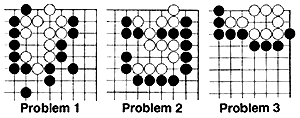Go online
In the past, if you wanted to play go, your only options would be to visit a go club or play with a friend at his home or yours. Today, however, the Internet offers a third option--playing online.There are a lot of advantages to playing go on the Internet. Since go is played in different time zones, you can always find an opponent day or night. There are a large number of players at all levels, from beginners to professionals, so you can easily find an opponent around your playing strength. You do not have to worry about equipment: the online graphics are superb with easy to follow instructions. And with the option of choosing from a number of computer-generated language modes, there are no language problems.
There are a number of sites where you can play go, but the most popular is IGS, or the Internet Go Server at http://igs.joyjoy.net. At peak hours, there may be as many as 800 players logged on. Another site is the NNGS (No Name Go Server). Among Japanese-language sites, "San-san" is popular, and Toshiba Corp. has just opened its own go server, WWGo. A number of large Japanese companies are planning to launch similar servers, so these organizations will no doubt be spending a lot of money advertising their go servers, thereby promoting the popularity of the game. You can also play go on the Internet in Yahoo's gaming area (http://games.yahoo.com) and at Microsoft's MSN Gaming Zone (http://zone.msn.com). However, these two sites are not designed for the serious go player and are best for beginners who just want to get a few games under their belts.
Online go is starting to cut into the clubs where go players have traditionally congregated. There has recently been a decline in membership, and new clubs are having a hard time attracting members. This trend has not been so noticeable in Japan where most players are of the older generation and are not as computer savvy as those in their 20s and 30s. But, as time goes by, this is bound to change. In contrast, most players in Europe and the United States are about college age, and this is the age group that is quite knowledgeable about computers and finding its way around the Internet.
In spite of the decline in clubs, the go population in the United Staates and Europe seems to be increasing dramatically because of the Web. Beginners can learn go on the Internet and weaker players can easily enjoy games with strong players who will instruct them, pointing out their mistakes and suggesting better moves. Since participants can use a pseudonym on the Web, beginners are spared the embarrassment of having their mistakes associated with their real names.
The Web has also been a boon for the propagation of go among children. On the first Friday of every month, IGS runs a "cybercamp" where children can log on and play games with each other.
Still, with all its advantages, Internet go seems to lack a human element. Go, like all games, is a social activity, and the anonymity of the Web does not lend itself well to human contact nor the friendships that so often comes from meeting an opponent face-to-face. Also lacking are the tactile feel of the stones and the resonant click they produce on the board when fine equipment is used.
But whatever misgivings traditionalists such as myself might have about Internet go, playing go on the Web seems to be the wave of the future and is perhaps best way for go to become a major game in the West.
Sacrifice tactics
Last week, I gave an example of how sacrificing a stone can kill an opponent's group. Here are some more examples.
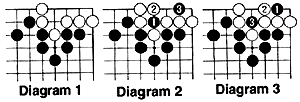 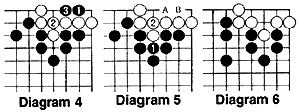
|
Reversing the order of moves by making a placement at 1 before sacrificing at 3 in Diagram 3 also works. As before, the point at 3 is a false eye, so White is left with only one real eye.
White might connect at 2 in Diagram 4 in response to the placement of Black 1. However, Black will answer by extending to 3 and White is unable to make two eyes.
If Black fails to sacrifice a stone and simply ataris with 1 in Diagram 5, White will be left with a four-point eye space after he connects at 2 and his group is alive. That is, if Black makes a placement at A, White plays B and he has two eyes. If Black plays B first, White will play A.
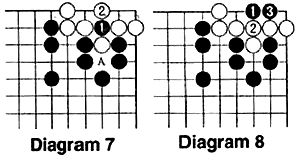 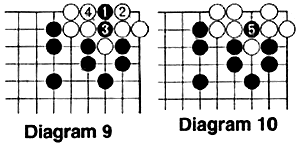
|
Black 1 in Diagram 8 is the key point in this position. If White connects with 2, Black extends to 3 and White cannot make two eyes.
Now for the sacrifice. Suppose that White answers Black 1 with 2 in Diagram 9. Black will now play 3, letting White capture two stones with 4.
Black can now throw in a stone at 5 in Diagram 10, leaving White with only one real eye on the 1-1 point and a false eye at 5, so the white stones are dead.
Below are three problems involving sacrifices. Problems 1 and 2 use the same technique shown in Diagram 6.
